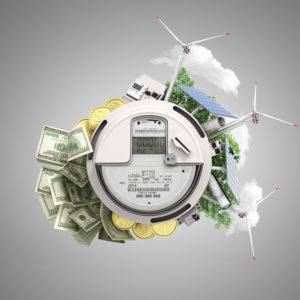The most common state-based climate policy has been slowly raising electricity prices across the country for decades—costs that far exceed the value of its carbon reductions — a new study by the University of Chicago’s Energy Policy Institute (EPI) reveals.
Starting in 1983, states began passing Renewable Portfolio Standards (RPS), which mandate a certain percentage of a state’s energy supply must be generated from renewable sources. For example, Illinois requires that 25 percent of the state’s power come from renewable sources by 2025.
Twenty-nine states and the District of Columbia impose RPS mandates, and seven more have RPS guidelines that utilities are encouraged but not required to follow. Nearly two-thirds (62%) of the nation’s energy is generated in jurisdictions covered by RPS mandates, according to the EPI study.
Supporters of Renewable Portfolio Standards often argue that they don’t raise electricity prices, or if they do, the costs are insignificant. Utility companies, on the other hand, say these mandates do in fact raise prices. The EPI study measured both direct and indirect costs imposed by RPS laws and concluded that “electricity prices increase substantially after RPS adoption.”
The study found that RPS mandates cause electricity rates to rise by 11 percent within seven years and by 17 percent within 12 years.
The largest burden of RPS laws falls not on businesses, the study found, but on residential ratepayers. This contradicts a common claim made by advocates of renewable energy mandates.
“The estimated increases are largest in the residential sector, but there are economically significant price increases in the commercial and industrial sectors too.”
Studies of RPS impacts have failed to capture their full cost because they tend to measure only the direct cost of new renewable generation, the authors of the EPI study say. Their review found much higher costs because it included a comprehensive examination of indirect impacts such as transmission and stranded costs.
“A particularly striking finding is that the indirect costs of RPS programs, which were not possible to comprehensively measure before, appear to account for the majority of RPS program costs,” the study found.
Renewable generation facilities such as wind and solar farms are sited far from population centers, which imposes high transmission costs. And when a new renewable facility reduces the output of an existing power plant, electricity costs rise because ratepayers must cover the costs of maintaining and running two plants that operate only part of the time.
When all costs are included, the study found that RPS laws are an extremely expensive and inefficient way to reduce carbon emissions.
When the carbon reduction attributable to RPS laws is tallied, “the cost per metric ton of CO2 abated exceeds $130 in all specifications and can range up to $460, making it at least several times larger than conventional estimates of the social cost of carbon,” the study concluded.
The authors believe that reducing carbon emissions should be an urgent priority. But they conclude that other methods would be more effective and less expensive than RPS laws.
“The increasing urgency of climate challenge means that the case for ruthlessly seeking out the least expensive reductions in carbon emissions is rapidly strengthening,” study co-author Michael Greenstone, director of the Energy Policy Institute and former chief economist for President Obama’s Council of Economic Advisors, said in a statement.
“This study joins a growing body of evidence that demonstrates that when climate policies favor particular technologies or target something other than the real enemy—carbon emissions—the result is less effective and more expensive than is necessary. In contrast, the global experiences from carbon markets and taxes make clear that much less expensive ways to reduce CO2are available right now.”
Far from pulling back on RPS mandates, however, legislators in many states are aggressively accelerating them this year.
Legislators in Illinois are pushing a bill to raise that state’s RPS mandate from 25% renewable energy to 40%.
Nevada legislators just passed a bill to raise the state’s RPS to 50% by 2030 and 100% by 2050.
New Hampshire legislators are trying to raise that state’s RPS from 25% to 60% by 2040.
Massachusetts has advanced legislation to set an RPS of 100% by 2047.
The governors of New York and Maine have pledged to move their states to 100 percent renewable energy.
Washington, D.C. passed an RPS of 100%in January.
Washington state also passed an RPS of 100% this year.
The study suggests that imposing stricter RPS mandates, as these states are striving to do, will drive prices even higher, as price increases are tied directly to the stringency of RPS requirements.
“RPS program passage leads to substantial increases in electricity prices that mirror the program’s increasing stringency over time,” the study found.

